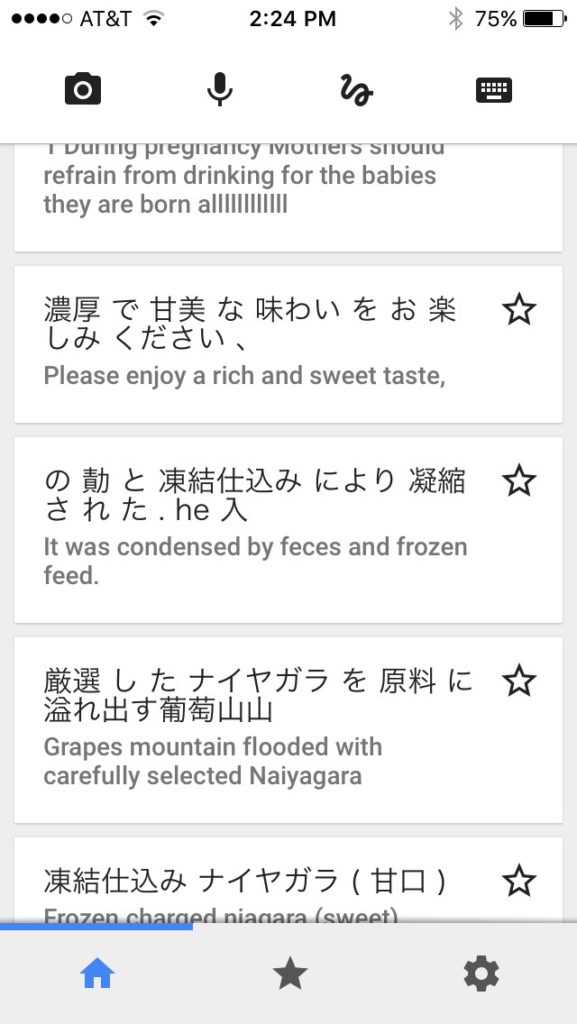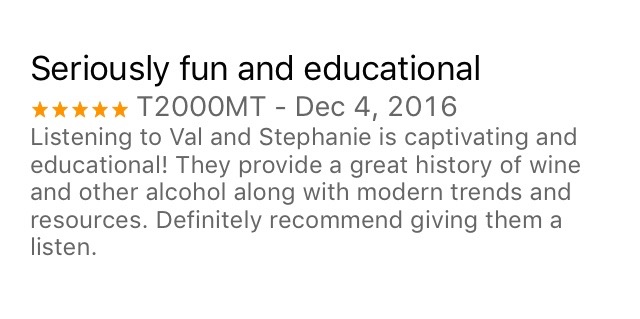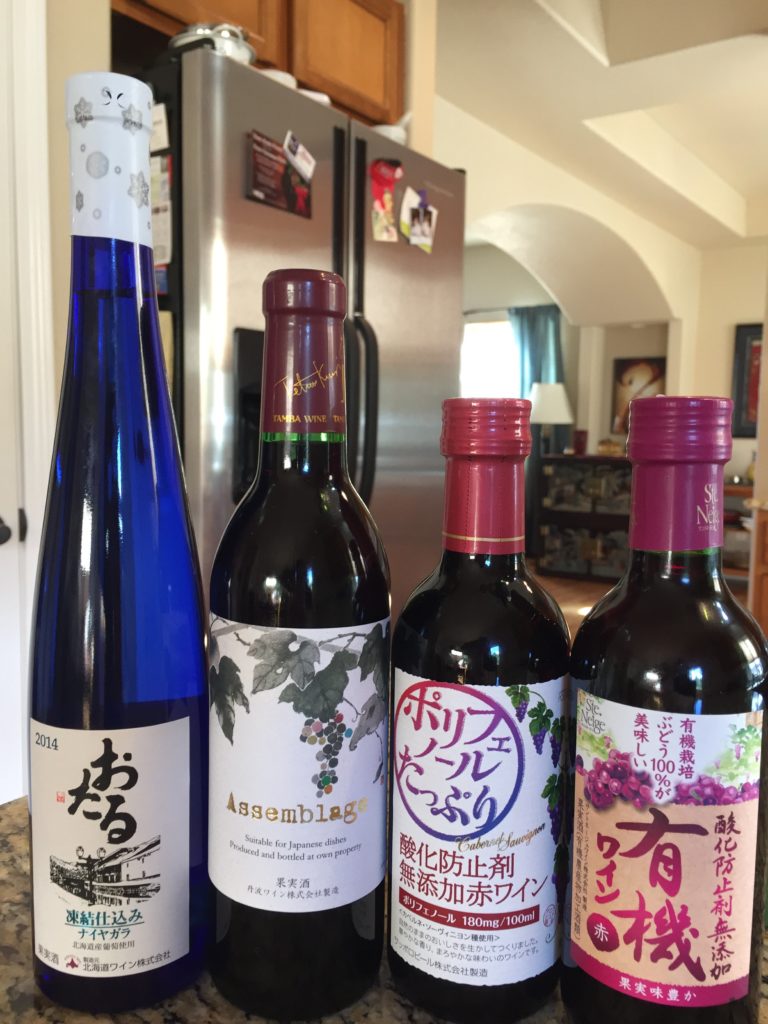Let’s just talk a little bit about the wines (plural) we have in our glasses today and how they got here. We have four bottles of Japanese wine that were sent to us from Carl Rosa, the founder of the Sushi Club of Houston, Explore Sushi, Sushi Science, Ramen in Common, Journey 2 Japan, among several other businesses promoting Japanese culture, including his Raw Conversations podcast, in case you’re interested in learning more about food and travel in Japan.
Val met Carl in person back in July for a two-hour sushi and wine pairing session, and they are planning some educational events for 2017. This dude? Knows his sushi, and even taught Val quite a few things about it. If you get a chance to take any of his classes, and you’re a lover of true, good sushi, Carl’s the guy. So you can imagine how she was that he chose Vino With Val (her wine education company) to work with him on his sushi-pairing projects. Additionally, in Carl’s hunt for the best of all things Japanese, been so generous to bring back these bottles, and they have been waiting until Steph & Val could dig in together and try them! So thanks, Carl, and Kanpai (Kanpai or 乾杯 means “cheers”).
Wine #1: Tamba Wine, Assemblage Rouge, no vintage, although this was sent last year. This winery was founded in 1979 and is near Kyoto. This is a red blend that has at least Cabernet Sauvignon and Merlot, but could have up to nine grapes in it, according to my translator app. The philosophy behind this winery is to make wine that is complementary to Japanese cuisine.
Wine #2: Wine #2 is from Asahi Breweries, but it’s their wine brand called Ste Neige. (Sacred Snow). It is from the Kofu Basin in the Japanese Alps and falls into the Yamanishi prefecture (which grows 25% of Japan’s grapes and contains nearly 60 wineries). This wine is produced and is considered certified organic, no sulfites added. They’ve been growing vinifera grapes here since the early 1950s and embrace the motto, “Good wine comes from good grapes.”
Wine #3: In keeping with the breweries getting in on the winemaking game theme, this next wine is the Sapporo Polaire Cabernet Sauvignon, Katsunuma district (about 15% of the Yamanishi grapes are grown here), in the Yamanishi prefecture.
Sapporo (yes, the beer company) launched this wine brand in 2003. This wine is made with imported grape juice which is quite common. In fact, when the winery first opened they were using wines from Yakima Valley in Washington State.
Now, this is interesting because this is considered better climate due to higher elevation, more breezes to stave off mildew, diurnal shifts, and lower rainfall for growing grapes. Yet, the previous wine from the Kofu basin comes from a much lower elevation with more rain. Remember, vines have to struggle. So the monsoonal climate down below, as you can imagine, aren’t ideal.
Another interesting point to be made here is that grape-growing is storied to have begun in this area by a buddha back in 718 (according to a favorite resource for all things wine, the current edition of The Oxford Companion to Wine). Yet, winemaking didn’t actually start happening until the late 19th century.
It is this prefecture, Yamanashi, that can account for nearly 40% of all the vineyards, along with Nagano and Yamagata – all located on Japan’s main island of Honshu.
Wine #4: This is a 2014 Hokkaido wine made in the ice wine style with Niagara grapes. Here they also grow Kerner, Zwiegelt, Gewurztraminer and even have some German on the label, so there’s a German influence here. From what I can tell they’ve been making wine here since 1974. Unlike the other three wines, this one is from the island of Hokkaido, which is the most northern Island and second largest. It’s cold here, hence the frozen grapes made into this ice wine style. They actually have to bury the vines here in the winter to keep them from being destroyed with temperatures dropping well below zero.
Some points:
- These were hand-carried back from Japan, so chances are these are not available in the US, at least these exact versions. Furthermore, they tend to keep their wines made with domestic grapes for their domestic market and these can be pricey.
- 36/47 prefectures make wine
- 75% of wine bottled relies on bulk or concentrated juice that’s imported
Grapes
- Koshu is the grape they are most known for, in terms of indigenous varieties. Grace Winery is known for excelling at this and is probably one of the more well-known brands for quality. This is imported to the US by Vizcaya as well.
- 90% of the Koshu is grown by Katsunuma wine in the Yamanishi prefecture. It’s ideal for the rougher climate and is quite a hearty, versatile grape with pinkish, thick skins that can fend off the hazards of damp environments.
- 90% of the grapes grown here are hybrids and only about 10% of the grapes grown are actually used for wine. These hybrids, like the Niagara, are based on the North American/US version of the Labrusca & are where we find the varieties classes such as Delaware, Concord, and Catawba.
- Other grapes grown here are the Delaware, mentioned earlier (about 20% of vines), Kyoho (Concord, about 35%), Neo-Muscat and Muscat Bailey A (red) and some others we may probably never see: a wild grape known as Yamabudo and Kiyomi. There’s also a following for Pione (3rd most popular) and is used for rose’.
- The European or International varieties comprise less than 1% of vine plantings.
On a lighter note:
We really did try hard to translate some of the kanjii characters on the bottles … but then this happened:
 However, we were not deterred. We enjoyed trying the wines with different foods and hope you’ll be able to try some too. Our tasting notes are in the audio of this episode and we hope you’ll enjoy that too. Overall, only one of these wines was truly dry (the Assemblage, or wine #1). The others were intended to have some off-dry, fruity quality, not tannic at all, and we can imagine they would be great with a salty/umami teriyaki dish! The wine in the blue bottle was, of course sweet and more of a dessert style wine.
However, we were not deterred. We enjoyed trying the wines with different foods and hope you’ll be able to try some too. Our tasting notes are in the audio of this episode and we hope you’ll enjoy that too. Overall, only one of these wines was truly dry (the Assemblage, or wine #1). The others were intended to have some off-dry, fruity quality, not tannic at all, and we can imagine they would be great with a salty/umami teriyaki dish! The wine in the blue bottle was, of course sweet and more of a dessert style wine.
For more information on Japanese wine go to http://visitjapanesewinery.com/
PATREON LOVE & GIVEAWAY:
Final two weeks! A copy of Uncorking the Caucasus: Wines from Turkey, Armenia, and Georgia, written by our recent guests Charine Tan and Dr Matthew Horkey from Exotic Wine Travel, will be given away the first week in January!
Here’s how to enter: Your name will be entered into the drawing for the book if you are already a Patreon supporter and if you become a Patreon supporter – at ANY level in November or December. The contest ends January 1st, 2017. You’ll get an entry for each dollar amount for the month of November & December! If you pledge $1/month this month you’ll get one entry. $5/month you’ll get 5 entries. Then we re-enter you for December & the winner will be drawn the first episode in January! For more information, check out our Patreon Page.
Thank you so much to our Patreon supporters! Sending out some Patreon Love to:
Jeff E from the hilarious drinking show, We Like Drinking
Oh, and did we mention we were guests on their show for Episode 99? Like, both Steph and Val at the same time? It was a riot and we certainly had a great time with our podcasting brothers from anotha mutha. Check it: http://welikedrinking.com/podcast/a-reserve-style-podcast-wld-099/
“It’s not five o’clock and we don’t care” listeners: Thank you:
- Meg from South Dakota
- Clay from Arizona
- Jon in California
- Andrew in Illinois
To learn more and become a Winetastic Listener Supporter for only $1 per month, check out our patron only content at https://www.patreon.com/winetwofivepodcast!
SHARE THE LOVE:
Please share Wine Two Five with your friends and online community, and we certainly appreciate all your involvement and feedback. Leave us a burning wine question or comment on speakpipe. iTunes love is always appreciated in the form of a glowing iTunes review as well. For your listening pleasure, whether IOS or Android, we are also on iHeartRadio! So share our fun W25 community with all the wine lovers in your life!
Thank you, thank you, thank you for this latest review on iTunes: 
Come play with us on our FB page, Twitter, Pinterest & YouTube, Google+ spaces if you’d like. Also, if you want to build your collection of wine books (like this one, also available on kindle!) or accessories please check out the online store also located on our website!
Connect with Val on Twitter @WineGalUnboxed and on the Vino With Val FB page, and on Instagram as Vino with Val.
You can find Steph on Twitter @Albarellosoap and on the AlbarelloSoap FB page, and check out the videos on the Albarello YouTube channel! Steph is also on Instagram as the Wine Heroine.
One more thing … don’t forget to use the #W25Challenge when you are trying new wines and drinks to win an opportunity to co-host the show with us. Until next week …. Cheers!

